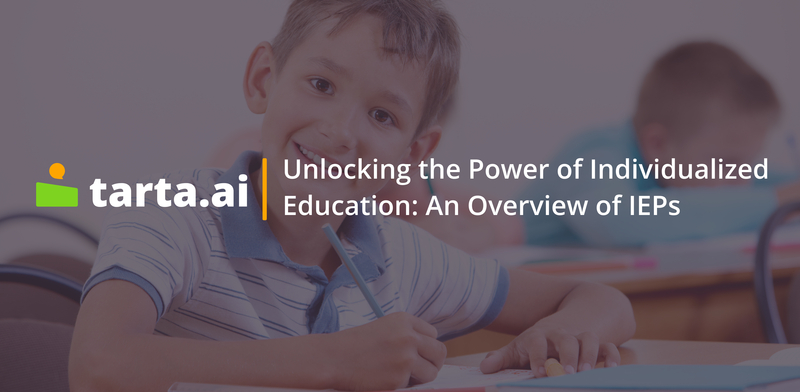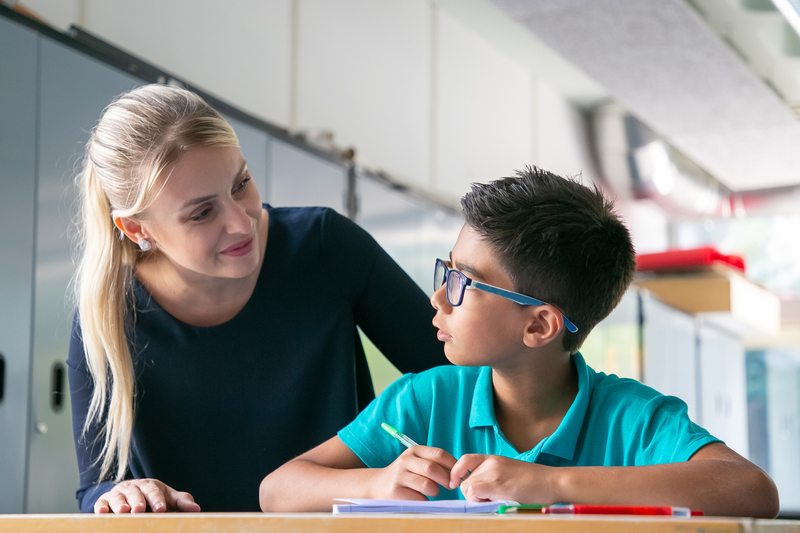Unlocking the Power of Individualized Education: An Overview of IEPs

An Individualized Education Program (IEP) is a legally binding document that outlines the specialized education and related services that a child with a disability will receive in a school setting. The IEP is designed to ensure that the child receives a free and appropriate public education (FAPE) that meets their unique needs and helps them achieve academic and functional goals. In this article, we will discuss the purpose of an IEP, how it is developed, its components, review and revision, and its importance.
The concept of IEPs was first introduced in the Education for All Handicapped Children Act of 1975, which is now known as the Individuals with Disabilities Education Act (IDEA).
Purpose of an IEP
The purpose of an IEP is to provide a roadmap for a child with a disability to receive the necessary educational and related services to help them achieve their academic and functional goals. The IEP ensures that the child receives an education in the least restrictive environment (LRE) possible, meaning they are placed in a classroom setting that meets their needs but allows them to interact with their peers without disabilities to the maximum extent possible.
The IEP also includes a plan for how progress will be measured and reported to parents. This plan outlines how progress towards the student's goals will be monitored and reported to parents, and how often progress will be assessed. This helps to ensure that the student is making progress towards their goals and that any necessary changes to the IEP can be made in a timely manner.
Developing an IEP
The development of an IEP is a collaborative process between the school and the child's parents or guardians. The process typically starts with a referral for evaluation, which can be initiated by the parents, school, or another agency. Once the evaluation is completed, the school team will review the results to determine eligibility for special education services under the Individuals with Disabilities Education Act (IDEA). If the child is found eligible, the IEP team will meet to develop an appropriate plan.
Students with disabilities who receive special education services under IDEA are required to have an IEP.
Components of an IEP
An IEP typically includes the following components:
- Present Level of Performance: A summary of the student's current academic and functional performance, including strengths, weaknesses, and any barriers to learning.
- Annual Goals and Objectives: A statement of the measurable annual goals that the student is expected to achieve in the coming year, as well as the specific objectives or benchmarks that will be used to measure progress towards those goals.
- Special Education and Related Services: A description of the special education and related services that the student will receive, including the frequency, duration, and location of these services.
- Participation in General Education: A statement of the extent to which the student will participate in general education classes and activities, and any accommodations or modifications that will be made to facilitate this participation.
- Accommodations and Modifications: A list of any accommodations or modifications that the student will receive to address their disability-related needs.
- Transition Planning: For students who are 16 or older, the IEP must include a statement of the student's transition service needs, including goals related to postsecondary education, employment, and independent living.

Photo: freepik
Review and Revision of an IEP
The IEP is reviewed at least once a year, and revisions can be made as needed. The review provides an opportunity for the IEP team to discuss the child's progress towards their goals, determine if any changes need to be made to the services or goals, and ensure that the child is receiving an appropriate education.
During the annual review of the IEP, the IEP team will typically gather information about the child's progress towards their goals and objectives, as well as any new information about the child's disability or educational needs. This may include:
- Evaluation results: The IEP team may review any new evaluation results or other assessments that have been conducted since the last IEP meeting to determine if the child's needs have changed or if new services or goals are needed.
- Progress reports: The child's teachers and service providers will typically provide progress reports on the child's academic and functional progress towards their IEP goals. These reports can help the team determine if the child is making sufficient progress or if changes need to be made to the IEP.
- Parent input: Parents or guardians are an important member of the IEP team and can provide valuable input on their child's progress and needs. The annual review provides an opportunity for parents to share their perspectives on their child's progress and any concerns they may have.
- Transition planning: For children who are approaching the end of their secondary education, the annual review may also include discussion of transition planning. This can involve setting goals and objectives related to postsecondary education, employment, and independent living, as well as identifying any needed services or supports to help the child achieve those goals.
Based on the information gathered during the annual review, the IEP team may revise the child's goals and objectives, adjust the services or supports provided to the child, or make other changes to the IEP as needed. The goal of the review and revision process is to ensure that the child is receiving an appropriate education that meets their unique needs and helps them make progress towards their goals.
Under IDEA, schools must provide parents with a copy of their child's IEP at no cost.
Note:
Under IDEA, schools must provide parents with a copy of their child's IEP at no cost.
Getting an IEP for a child
To get an IEP for a child, the following steps are typically taken:
- Referral: The first step in getting an IEP is to make a referral to the child's school or school district. Anyone can make a referral, including parents, teachers, and doctors. The referral should include information about the child's disability and how it affects their ability to learn.
- Evaluation: Once a referral is made, the school or district will evaluate the child to determine if they are eligible for special education services. The evaluation may include academic, medical, and psychological assessments.
- Eligibility determination: After the evaluation is complete, the IEP team, which includes the child's parents, teachers, and other professionals, will meet to determine if the child is eligible for an IEP. The team will consider the results of the evaluation and whether the child's disability affects their ability to learn and participate in school.
- IEP development: If the child is eligible for an IEP, the IEP team will develop an individualized education program for the child. The IEP will include information about the child's strengths and weaknesses, goals for the child to achieve, and the services and accommodations that the child will receive.
- Implementation: Once the IEP is developed, the school or district will implement the services and accommodations outlined in the IEP. The child's progress will be monitored, and the IEP will be reviewed at least once a year to determine if any changes need to be made.
Overall, the process of getting an IEP can be complex, but it is important for children with disabilities to receive the necessary support and accommodations to succeed in school. Parents and caregivers can work with the school or district to ensure that the child receives an appropriate education and that their needs are met.

Photo: pch.vector/freepik
Importance of an IEP
An IEP is essential for children with disabilities as it ensures that they receive the necessary specialized education and related services that meet their unique needs. It also provides a clear plan for the child's education, goals, and progress. The IEP serves as a legal document that outlines the school's responsibilities to provide the child with a free and appropriate public education in the least restrictive environment. It also ensures that parents or guardians have a say in their child's education and that their concerns and opinions are considered in the development of the IEP.
Note:
IEPs can include a variety of services and supports, including specialized instruction, speech and language therapy, occupational therapy, physical therapy, and counseling.
IEPs can include a variety of services and supports, including specialized instruction, speech and language therapy, occupational therapy, physical therapy, and counseling.
Tips for Parents and Educators in the IEP Process
- Establish open communication: It's important to establish open lines of communication between parents and educators from the very beginning of the IEP process. This can help ensure that everyone is on the same page and that the student's needs are being met.
- Understand the process: Make sure both parents and educators understand the IEP process, including the timelines, documentation, and requirements. This can help prevent misunderstandings and ensure that everyone is working towards the same goals.
- Involve the student: Whenever possible, involve the student in the IEP process. This can help them feel more invested in their own education and ensure that their voice is being heard.
- Identify specific goals: Work together to identify specific goals for the student, based on their needs and abilities. These goals should be measurable, realistic, and achievable.
- Develop an action plan: Once goals have been established, develop an action plan that outlines the specific steps that will be taken to help the student achieve those goals. This can include things like accommodations, modifications, and specialized services.
- Monitor progress: Regularly monitor the student's progress towards their goals and adjust the action plan as needed. This can help ensure that the student is making progress and that the IEP is meeting their needs.
- Advocate for the student: Both parents and educators should advocate for the student throughout the IEP process. This can include advocating for additional services or accommodations, communicating with other school staff, and ensuring that the student's needs are being met.
- Attend IEP meetings: Finally, make sure to attend all IEP meetings and come prepared with any questions or concerns. This can help ensure that the student's needs are being addressed and that everyone is working together towards a common goal.
In conclusion, the Individualized Education Program (IEP) is a vital component of the Individuals with Disabilities Education Act (IDEA). It is designed to ensure that students with disabilities receive a free and appropriate public education (FAPE) that is tailored to their unique needs. The IEP is a legally binding document that outlines the student's present level of academic achievement and functional performance, measurable annual goals, services and accommodations, and progress monitoring and reporting. The IEP team, which includes the student's parents, teachers, and other educational professionals, should work collaboratively to create an IEP that will help the student succeed in school and beyond.
- An Individualized Education Program (IEP) is a legally binding document that outlines the specialized education and related services that a child with a disability will receive in a school setting.
- The purpose of an IEP is to provide a roadmap for a child with a disability to receive the necessary educational and related services to help them achieve their academic and functional goals, ensuring that they receive a free and appropriate public education (FAPE) that meets their unique needs.
- Components of an IEP typically include a summary of the student's current performance, measurable annual goals, descriptions of special education and related services, statements on participation in general education, accommodations and modifications, and transition planning for students who are 16 or older.
- The IEP is reviewed at least once a year, and revisions can be made as needed based on the child's progress towards their goals and any new information about their disability or educational needs.
- To get an IEP for a child, the steps typically involve a referral, evaluation, eligibility determination, IEP development, and implementation.
- The IEP process can be complex, but it is important for children with disabilities to receive the necessary support and accommodations to succeed in school.
FAQ
Who is eligible for an IEP?
Who is eligible for an IEP?
What is the purpose of an IEP?
The purpose of an IEP is to provide a comprehensive plan outlining the special education and related services that the child will receive. It is designed to address the unique needs of each child with disabilities and ensure they receive a free and appropriate public education in the least restrictive environment possible.
Who develops the IEP?
The IEP is developed by a team of professionals, including the student’s parents, special education teacher, general education teacher, and any other relevant school personnel. The student may also be included in the process, depending on their age and level of maturity.
Can parents request changes to the IEP?
Yes, parents have the right to request changes to the IEP at any time. It is important to note that any changes must be agreed upon by the IEP team, and the parents may need to provide additional information to support their request.
What happens if the school fails to provide services outlined in the IEP?
If the school fails to provide services outlined in the IEP, parents have the right to file a complaint with the school district or state education agency. Legal action may also be taken in some cases.
Can a student with an IEP participate in extracurricular activities?
Yes, students with an IEP have the right to participate in extracurricular activities and receive any necessary accommodations or modifications to enable their participation.